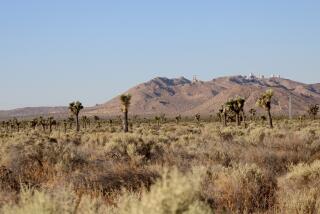Three ‘Sun Giants’ Loom in the Desert : Alternative Shelter
- Share via
Three plants are in operation in the desert north of San Bernardino, each generating electricity from the heat of the sun in a different way.
12p,10,,1 Alternative Shelter They’re not in formal competition, but most of the solar energy community, scientists, engineers, industrialists and others, are watching the trio, hoping for an advancement in knowledge that will take at least some of the burden of producing the nation’s electricity off the shoulders of our hard-pressed coal, oil and gas resources.
Two operate by concentrating sunlight in different ways to make steam for turbines to run generators. The third produces electricity directly from the sun through a process called “photovoltaics.”
The newest of the three is called SEGS I, for Solar Electrical Generating System. It was dedicated Feb. 14 at Daggett, near Barstow. A $62-million project, it is called by its developers the world’s largest privately financed solar electric generating plant, producing 13.8 megawatts of current that is sold to the Southern California Edison Co. grid.
It consists of 560 solar collector assemblies mounted in 140 rows and occupying a space of 770,000 square feet. Each assembly consists of four mirrored glass tracking troughs, each eight feet wide and 172 feet long, continually adjusted by computer to face the sun at the optimum angle.
The cross-section shape of the troughs, a parabolic curve, concentrates a long, thin line of intense sunlight--and therefore heat--on an oil-filled, black-painted, stainless steel pipe running lengthwise along it. The heated oil is used to produce superheated steam--780 degrees Fahrenheit--which powers a turbine to turn an electric generator.
On Edison Land
The plant was built on the basis of technology developed by Luz Industries (Israel) Ltd., a subsidiary of Luz International Ltd. of Encino, and is sited on 66 acres of Southern California Edison land. Other principal investors are First Interstate Bank of California and Great Western Savings & Loan Assn.
In large part, SEGS I was conceived and developed by Arnold J. Goldman, president and chief executive officer of Luz International, who, in 1970, is credited with pioneering word processing in the United States. In 1972 he became founding president of Lexitron.
Goldman is a computer and electrical engineer, born in Rhode Island and reared in Los Angeles where he attended both UCLA and USC. In 1977 he sold his interest in Lexitron to Raytheon and moved to Israel with his wife and five children and began to investigate parabolic trough solar technology.
The other prime mover is Newton D. Becker, Luz International’s board chairman and founder and director of the Becker CPA Review course, headquartered in Encino and with schools in 80 cities. He said SEGS I “is like an oil well that will never run dry. It is inexpensive to operate and maintain and poses no threats to the environment.”
Plan Second Phase
Luz plans a second phase, SEGS II, a $93-million, 30-megawatt plant, to go into construction later this year.
From Jerusalem, Goldman compared SEGS I to Solar One, on an adjacent parcel of Edison Co. land: “Solar One is a 10-megawatt power station that cost in the area of $141 million to build. SEGS I is a 13.8-megawatt station that cost $62 million to build.”
Solar One was dedicated Nov. 2, 1982, making it the oldest of the three plants under discussion here. Most of its cost was borne by the federal Department of Energy, with Edison and the Los Angeles Department of Water & Power sharing the $20-million cost of the steam generation unit. It also produces electricity by making steam from the sun’s heat to run generators but with different technology.
An array of 1,818 “heliostats” is placed in a semicircular array around a central tower, 300 feet high, on which is a water-filled “boiler.” Each heliostat consists of 12 glass mirrors, each 3 1/2 by 10 feet, tilted and turned as a unit. When all the heliostats are reflecting sunlight on the boiler, it receives the equivalent of 300 suns and the temperature hits 980 degrees Fahrenheit.
Solar ‘Trackers’
The third of the trio was dedicated Feb. 14, 1983, at Hesperia, near Victorville, and is the largest of its type in the world. It consists of 108 solar “trackers,” large, rectangular panels covered with silicon photovoltaic cells that convert the sun’s light directly into electricity. A computer re-aims each tracker every 30 seconds to keep the cells at the optimum angle to catch the sun’s rays.
The 20-acre installation cost $11 million and was designed and is owned and operated by Arco Solar, a subsidiary of Atlantic Richfield. Its capacity is one megawatt, enough to supply about 400 homes, and its output also is sold to Southern California Edison, which says it has more power coming to it from solar energy than any other utility in the world.
As noted before, this isn’t a formal competition but there can be no doubt that the three approaches to the problem will be very closely watched, analyzed and compared. There probably won’t be a single, formal determination of which is “best”; what can be expected is a broader and deeper understanding of the field that could go a long way toward making it possible to decide which is best suited to any particular area and set of circumstances.
It can be hoped that the final result will be greater use of the sun, as our single greatest source of renewable energy, to take the strain off our dwindling fossil fuel resources . . . and to cut everyone’s electric bills.
More to Read
Inside the business of entertainment
The Wide Shot brings you news, analysis and insights on everything from streaming wars to production — and what it all means for the future.
You may occasionally receive promotional content from the Los Angeles Times.










